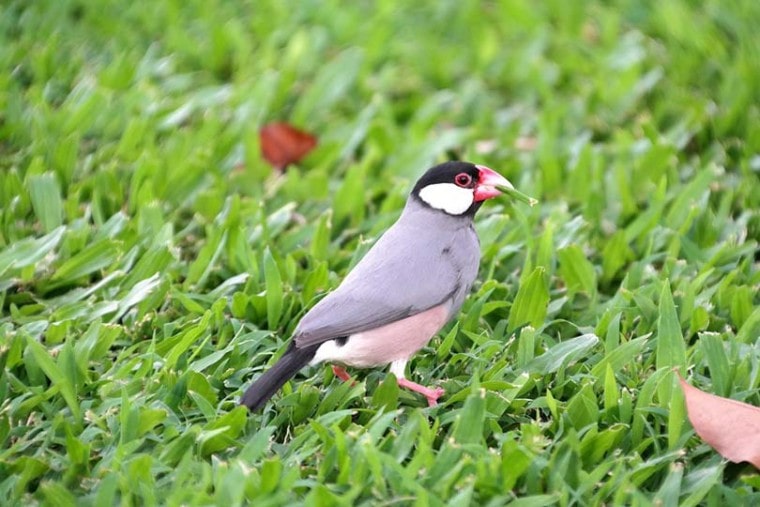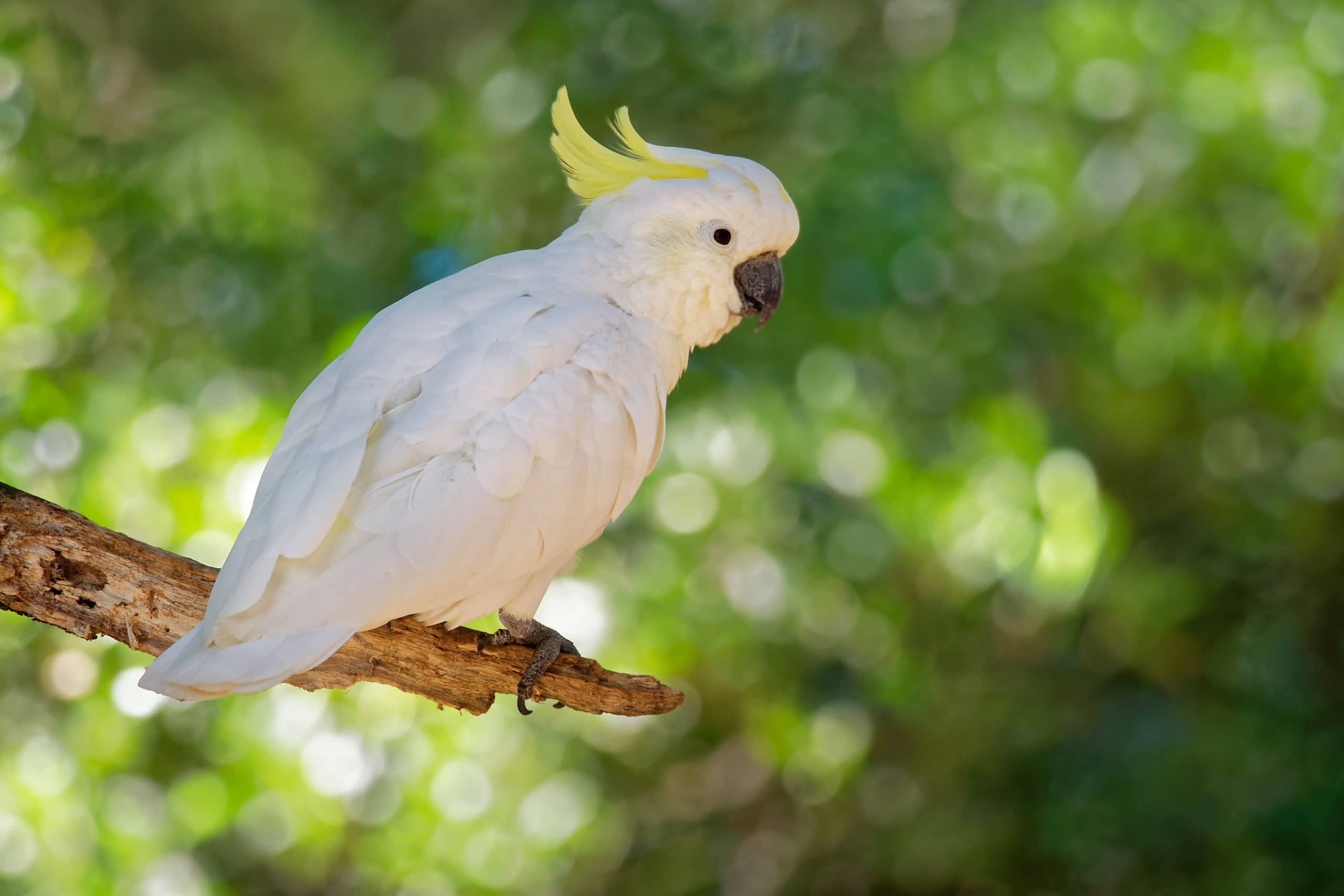
The Java Finch is popular as a pet bird, especially with people who are interested in keeping an aviary of birds that require relatively hands-off care. These birds are cute and create beautiful songs that can bring a peaceful ambiance to your home. They aren’t legal to own in all areas, though, so if you’re interested in owning a Java Finch, it’s important that you investigate your local laws regarding these birds.
Species Overview

| Common Names: | Java Finch, Java Sparrow, Java Rice Bird, Java Rice Sparrow |
| Scientific Name: | Lonchura oryzivora |
| Adult Size: | 5-6 inches |
| Life Expectancy: | 5-10 years |
Origin and History
The Java Finch is found in large flocks in savannas and grasslands across the islands of Indonesia, Hawaii, Sri Lanka, Puerto Rico, and Jamaica. They are fond of agricultural areas, especially rice paddies, and they are often considered to be a pest species by farmers. They can be damaging to crops, which is why it is illegal to own them in many areas where they are non-native. An introduced population of Java Finches in a non-native environment would be detrimental to the local ecosystem. Although they have been introduced in many areas, they are still considered an endangered species.
These birds have been kept as pets in Asia since at least the 17th century, with the Ming Dynasty being credited with first keeping and popularizing the bird. In the 1960s, these birds were introduced into the pet trade in the United States, where they rapidly rose to popularity. The import of Java Finches was eventually banned, and it is still illegal to own them in California, Hawaii, Georgia, Florida, and a few other states due to their threat to agriculture and the native ecosystem. Most pet Java Finches kept today are captive-bred.

Temperament
Although social, Java Finches prefer the company of other Java Finches to that of humans. Some people do successfully bond with their bird, but these birds can be quite timid when it comes to being handled by people. They are peaceful birds that can often get lonely without avian friends. They are happiest in small flocks, and it isn’t recommended to keep them singly as this can lead to stress and a shortened life expectancy for the bird.
Some male Java Finches have been known to show aggression toward other males, but they otherwise are content to peacefully coexist with other birds. Some people even find success keeping Java Finches with other types of songbirds, like Canaries and some other types of Finches.
Speech & Vocalizations
Java Finches are highly prized for their gentle song. They make a high-pitched “chip-chip” song that can be quite soothing. When males are attempting to woo a female, they may create drum-like noises by clicking their beak. These beak noises are done to accompany the male’s song, almost as if he is creating his own percussion to the song.
Java Finch Colors and Markings

A major distinguishing characteristic of Java finches is an orange ring around the eyes. They also typically have an orange beak, legs, and feet, as well as rounded, white patches on the cheeks. They have grey on their wings and back with a black head and tail. The chest and abdomen are typically grey to cinnamon. There are also a few color morphs that have evolved via selective breeding within the pet trade.
Caring for the Java Finch
Grooming
Provide routine misting every day or two for your Java Finch. You can also offer a bird bath of clean water. The bird should be allowed to air dry, but it’s important you protect it from any drafts while it dries. Nail and wing trims should be performed as needed by a properly trained person.
Cage Mates
Java Finches should not be kept singly. You should always keep them in pairs, at minimum. They are happiest in small flocks, though. Most people opt to keep a bonded pair.
Cage Setup
A cage with space for flight is ideal for these birds, but they can be kept in a birdcage with perches and activities if they are allowed time out of the cage every day. Anytime your Java Finches are out of the cage, they should be in a safe environment that doesn’t allow them to escape or interact with other pets or small children.

Common Health Problems
Java Finches are extremely hardy birds, so most illnesses can be prevented with proper care. They can develop fungal, bacterial, or viral infections if their enclosure isn’t cleaned and maintained properly or if new birds aren’t properly quarantined and cleared by a veterinarian before introducing to the environment.
These birds reproduce readily, so females may become egg-bound or develop deficiencies related to producing too many eggs on a regular basis. One way that people help control this issue is by planting small, fake eggs in the nesting box. This tricks the female into thinking she has eggs to care for, which will decrease her egg production.
Diet and Nutrition
Java Finches are primarily herbivorous and although they are known for consuming rice, they will eat just about any seeds and grains. They also enjoy some fruits. The base of your Java Finch’s diet should be a high-quality commercial bird seed mix. There are many commercial diets that are formulated for finches.
You can offer chopped fruits and veggies that are safe for birds, like melon, greens, and bananas. Additional nuts and grains not found in their commercial feed are acceptable dietary additions as well. Provide a source of calcium, like crushed eggshells or oyster shells. Java Finches can be picky and will pick around foods they aren’t interested in eating, which can be quite messy.
Exercise
With enough space in the cage, Java Finches don’t need time out of the cage. They will be content to fly around a spacious cage, and they should be provided with plenty of perches and toys. Providing activities for these birds is important to keeping them healthy, and it is especially important if you have a single Java Finch. When kept in pairs or flocks, they will often keep each other company and do activities together.

Where to Adopt or Buy a Java Finch
Your first step is to find out your local laws surrounding ownership of Java Finches. If you are purchasing a bird from a vendor in a different state, then you’ll need to find out what the laws are surrounding interstate transport of Java Finches. You may find these birds for sale in pet shops, but you are more likely to acquire healthy birds from a breeder who is familiar with the species and has had success breeding and raising them.
You may also find Java Finches through rescues, especially if you live near a state where these birds may not be legal to own. Some people who illegally own these birds are forced to hand them over to government agencies or rescues.
Conclusion
Java Finches are lovely birds that can be a fantastic addition to a laid-back home that isn’t looking for a pet that needs daily handling. If you are prepared to set up a proper enclosure for multiple Java Finches, then you won’t be disappointed by these social creatures. They are enjoyable to watch and to simply be around, since they will serenade each other with their lovely songs. Make sure you look into your local laws regarding the sale, transport, and ownership of these birds, though.
Featured Image Credit: Majaranda, Pixabay







